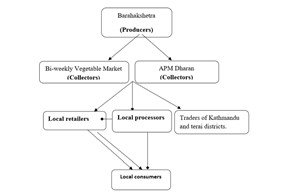Production and marketing of turmeric (Curcuma longa) in Sunsari District, Nepal
Abstract
Turmeric is a popular spice in Nepalese households and a potential cash crop in the country's tropical areas; yet, due to limited study on production technologies and marketing channels, Nepalese farmers have struggled to earn a reasonable return from its production. For this study, 100 turmeric producers were selected by using simple random sampling technique from total turmeric growing population registered in PMAMP at Barahakshetra Municipality of the district. The research was carried out during January to May. Primary data were collected through field, survey, FGD, and KII while a literature review was carried out as the source of secondary data. Information collected from the field survey were coded, tabulated, and analyzed by using the statistical software of MS Excel 2010 and SPSS V26.0. It was found that majority of the respondent farmers had agriculture as their primary occupation. The average household turmeric area was 0.43 ha. The labor cost contributed 45.46% for the of cultivation with an average cost of cultivation pf NRs.110.63 per kg for dried turmeric. Moreover, the gross return of Rs.270057 per hectare and the BCR 1.35, indicate that turmeric farming is profitable. The average productivity of dry turmeric in the study area was 1800 kg per hectare. Insufficient technical services and low market price of the turmeric were main production and marketing problem faced by turmeric producing community This study suggests the adoption of innovative technology for farming, government intervention in price fixing and replacement of local seed by improved seed.
Keywords:
Dry-turmeric, B/C Ratio, Price, Marketing, ProductionDownloads
References
Acharya, S., Dhital, P., Bista, B., Ghimire, A., & Airee, S. (2021). Resource Productivity Analysis of Organic Turmeric Production in Surkhet District, Nepal. Economic Affairs, 66(2), 189-194, https://doi.org/10.46852/0424-2513.2.2021.2
Bagchi, A. (2012). Extraction of Curcumin. Journal of Environmental Science, Toxicology and Food Technology, 1(3), 01-16.
Chhetri, G., Devkota, D., & Sharma, B. (2020). Value Chain Analysis of Turmeric Subsector In Surkhet District of Nepal. Chronic Complement Altern Integra Med: CCAIM-100010.
Deshar, B. D. (2013). An Overview of Agricultural Degradation in Nepal. Global Journal of Economic and Social and its Impact on Economy and Environment, 3(1), 1-20.
Hewlings, S. J., & Kalman, S. D. (2017). Curcumin: A Review of Its’ Effects on Human Health. Foods, 6(10), 92, https://doi.org/10.3390/foods6100092
HVAP. (2011). Value Chain Analysis Of Turmeric. Surkhet,Nepal: Government of Nepal,Ministry of Agricultural Development.
MoALD. (2017/2018). STATISTICAL INFORMATION ON NEPALESE AGRICULTURE 2074/75(2017/18). KATHMANDU: Ministry of Agriculture and Livestock Development.
MoALD. (2021). STASTISTICAL INFORMATION ON NEPALESE AGRICULTURE 2077/2078(2019/2020). Kathmandu: Ministry of Agriculture and Livestock Development.
MOF. (2019/2020). Economic Survey 2019/2020. singhadurbar, kathmandu: Government of Nepal, Ministry of Finance.
NAGRC. (2018). Crop Groups: Use value of Horticultural Crop Species in Nepal, National Agriculture Genetic Resource Centre. Working Groups of
Agricultural Plant Genetic Resources (APGRs) in Nepal.
Park, E. J., Jeon, C. H., Ko, G., Kim , J., & Sohn, D. H. (2000, April). Protective effect of curcumin in rat liver injury induced by carbon tetrachloride. J. Pharm. Pharmacol. 52: 437-440. Journal of Pharmacy and Pharmacology, 52(4), 437-440, https://doi.org/10.1211/0022357001774048
Plotto, A. (2004). Turmeric Post Harvest Operations. Food and Agriculture Organization.
Pritchard, N. (1969). A framework for analysis of agricultural marketing system in developing countries. USA: Van Nostrand Rein Hold Company.
Sarkar A, D. R. (2016). Curcumin as a potential therapeutic candidate for Helicobacter pylori associated diseases. World Journal of Gastroenterology., 22(9), 2736-48, https://doi.org/10.3748/wjg.v22.i9.2736
Shrestha, A., Baral , S., & Sharma, S. (2021). Factors Affecting Turmeric Production in Sunsari District, Nepal. International Journal of Environment, Agriculture and Biotechnology, 6(6).
Timilsina, K. P., Shrestha, K. P., Chapagain, T. R., & Pandey, S. (2011). Value Chain Analysis of Turmeric (Curcuma longa) in Eastern Nepal. Nepal Agriculture Research Journal, 70-79.
Timsina, K., Shrestha, K., Chapagain, T., & Pandey, S. (2011). Value Chain Analysis of Turmeric (Curcuma longa) in Eastern Nepa. Nepal Agricultural Research Journal.
TNAU. (2017, February – March). Turmeric Price Remain Stable. Retrieved from https://agritech,tnau.ac.in
White, G., & Raizada, M. (2014). An Intoduction to Turmeric and its Export Potential in Nepal.

Published
How to Cite
Issue
Section
Copyright (c) 2021 Agriculture and Environmental Science Academy

This work is licensed under a Creative Commons Attribution-NonCommercial 4.0 International License.

